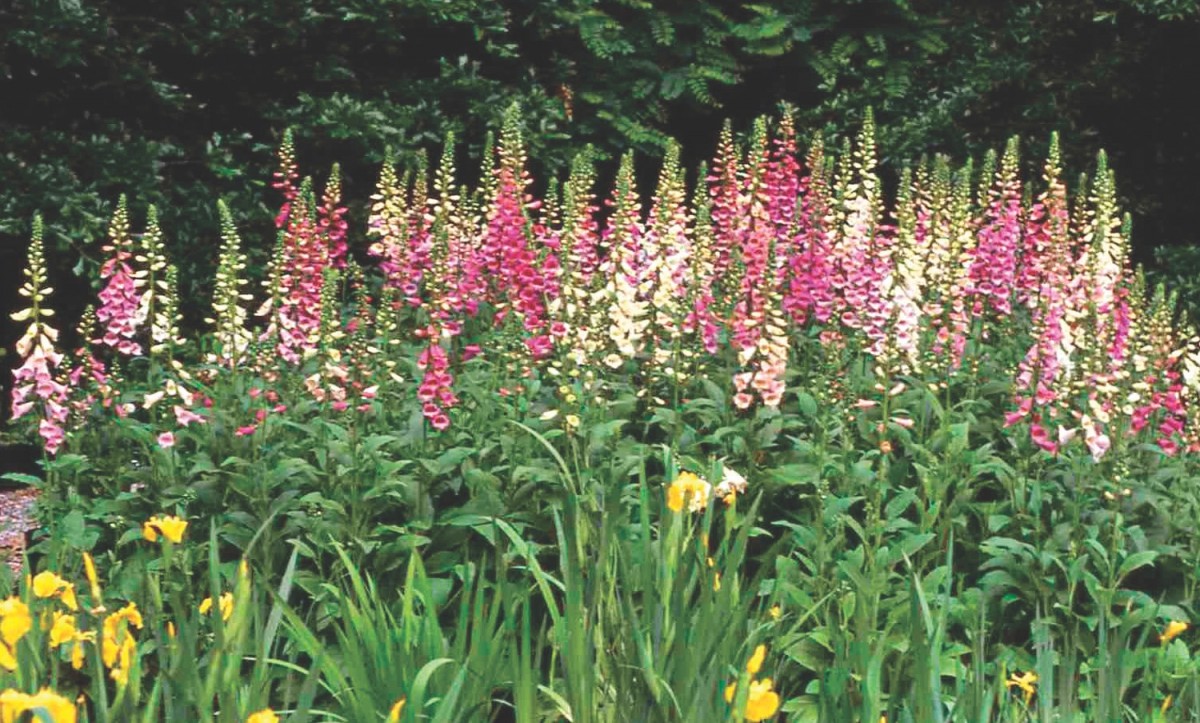
Photo by Michael Warwick | Shutterstock
Troy Rhone shares his tips for growing foxglove plants and enjoying your foxglove flowers, plus some of the most popular foxglove varieties.
The whimsical foxglove plant (Digitalis purpurea) has brought joy to my heart for years. And as far back as the 1700s, foxglove flowers have also brought physical healing to hearts in need. The man credited with the introduction of digitalis into the practice of medicine was William Withering, who first used extracts of the plant to help with Dropsy. Even Dr. Erasmus Darwin, grandfather of Charles Darwin, wrote a poem extolling the good effects of this lovely flower.
In our modern times, certain compounds found in the leaves are used to help in the fight against cardiac disease. And while its extracts prove beneficial, the foxglove plant itself—stems, flowers, leaves and all—is entirely toxic and should not be ingested.

Foxglove ‘Excelsior’ mix.
KNOWING AND GROWING FOXGLOVES
Foxgloves blooms May to June. Most foxglove plants are biennials. This means they have vegetative growth the first year and flower the second year.
Foxgloves need to be staked before the florets open. Once they open the weight of the flower can break the stalk.
Foxgloves do best in morning sun light with afternoon shade.
When it comes to pruning foxglove, remove the center flowering stalk after it blooms. This will enable the side stalks to have more energy to grow and bloom.
Cut foxgloves for arrangements just before the blooms reach their peak.
WHEN TO PLANT FOXGLOVES
While some are perennials, most common foxglove varieties are biennial. This means that when grown from seed, in their first year, they will grow out their root system and produce leaves, go dormant over winter, and will bloom in the summer of their second year.
Plant seeds in spring, after the threat of frost for flowers the following year.
If you’re impatient for blossoms, you can let a grower spend part of that first, flowerless year with the plant, and purchase established foxgloves to set out in late summer or fall. As with seed-grown plants, the foxgloves will be dormant through the winter, sprout in spring, and bloom in early summer.
Biennial foxglove varieties will die after they flower and produce seeds. Some foxglove varieties will give you a second year of flowers if you cut off the flower stalk before it sets seeds. Whether you purchase plants or start with seeds, you’ll want to plant two years in a row so that you’ll have plants in flower every year.
FOXGLOVE FLOWER HISTORY AND FOLKLORE
The foxglove plant has been around for centuries and stories of how it got its name are just as colorful as its flowers. The name ‘foxglove’ seems to derive from one of two stories told in Scandinavia.
The first one tells of fairies saving the foxes from extinction by showing them how to ring the digitalis bells to warn their kind of the danger of approaching hunters. The second tells of foxes putting on florets as gloves so their steps would be quieter when approaching the chicken coop.
In Wales, digitalis was called Goblin’s Gloves because it was believed that hobgoblins wore the long bells on their fingers and they would impart magical elements to the wearer.

Photo courtesy of Goodness Grows
‘Foxy’ mix planted with columbine (Aquilegia)
FOXGLOVE COMPANION PLANTS
Foxgloves are very beautiful on their own, but when accompanied with other flowers from the garden they can make a spectacular arrangement. Mix foxglove flowers in arrangements with others that may be blooming in your garden, such as, snapdragons, delphiniums, dahlias, irises, and lilies-of-the-valley.

Photo courtesy of Goodness Grows
‘Foxy’ mix selection planted with yellow flag iris.
EIGHT POPULAR FOXGLOVE VARIETIES AND SEED SOURCES
- ‘Pam’s Choice’ foxglove: Grows 36”–48” stately stems covered with bell-shaped white florets accented by deep maroon throats. Find seeds here.
- ‘Foxy’ mix: Grows 24”–36” tall. Colors are soft pastels. This mix flowers five months from planting seed, so it can be used as an annual. Find seeds here.
- ‘Excelsior’ mix: Stalk is 36”–48” tall with long, large flowers! Florets are borne on all sides of the spike rather than on one side as on other foxgloves. They also face outward rather than downward. Find seeds here.
- Alba’ is a 36”–48” spike of white flowers that lacks the normal spotting on throats of the florets. Find seeds here.
- ‘Primrose Carousel’: 30” true to seed yellow with splotches in the throat. Florets swirl around the stem. Find seeds here.
- ‘Camelot’ mix: Rose, white, lavender, and cream flowers on a tall 40” stem. Find seeds here.
- Strawberry foxglove (Digitalismertonensis) Grows 30”–36” tall with its unique strawberry-red florets. Find seeds here.
- Yellow Foxglove (Digitalis grandiflora) A true perennial foxglove that grows 24”–36” tall with bright yellow flowers. Find seeds here.
By Troy Rhone



